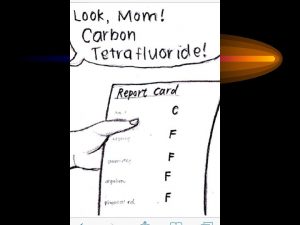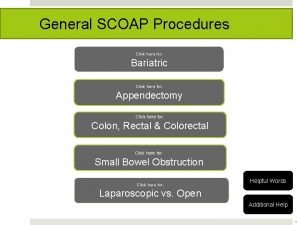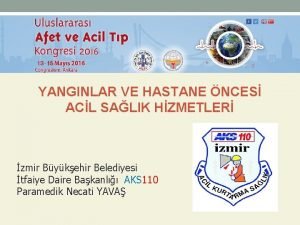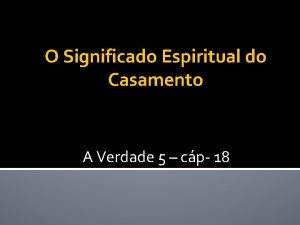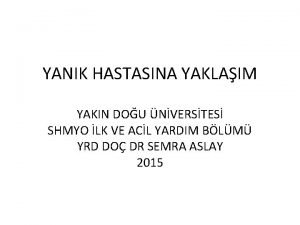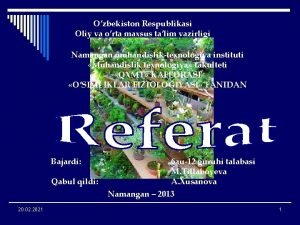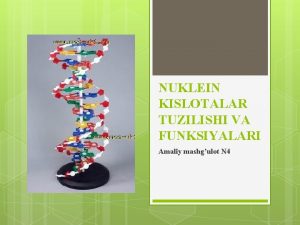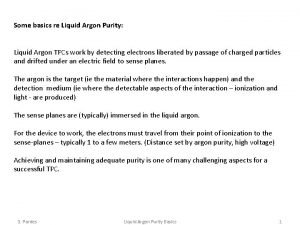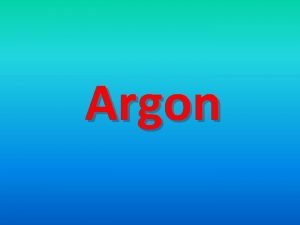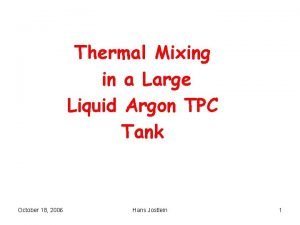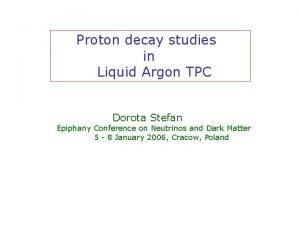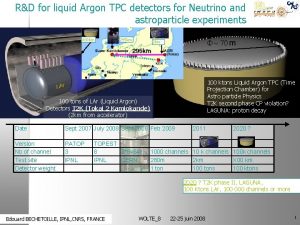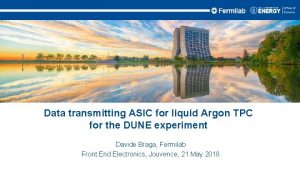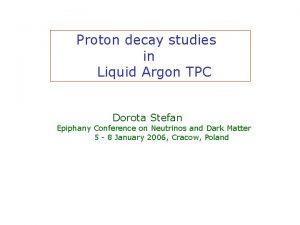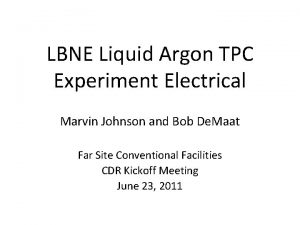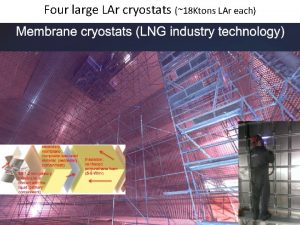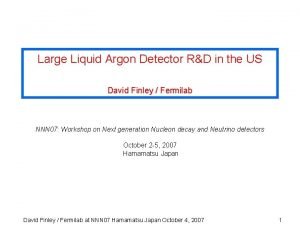LAr TPC Large Liquid Argon TPC for the













- Slides: 13

LAr. TPC: Large Liquid Argon TPC for the Nu. MI Off-axis Beam Brief description of some of the efforts of the LAr. TPC group which is pushing the development of large liquid argon TPC’s aimed at upcoming neutrino experiments as well as experiments in a neutrino factory era. Greg Bock FNAL/BNL Meeting November 14, 2005 (Almost entirely a selection of slides from Dave Finley’s presentation to the ISS)

The promise of liquid argon Electrons compared to 0's at 1. 5 Ge. V in LAr TPC Dot indicates hit, color is collected charge green=1 mip, red=2 mips (or more) X plane cm zoom in U plane cm zoom in Electrons Single track (mip scale) starting from a single vertex Multiple secondary tracks pointing back to the same primary vertex Each track is two electrons – 2 mip scale per hit use both topology and d. E/dx to identify interactions

The Large Liquid Argon TPC Aim is to produce a viable design for a 15 kt - 50 kt liquid argon detector. Basic concept follows ICARUS: TPC, drift ionization electrons to 3 sets of wires (2 induction, 1 collection) record signals on all wires with continuous waveform digitizing electronics Differences aimed at making a multi-kton detector feasible; Construction of detector tank using industrial LNG tank as basic structure Long(er) signal wires Single device (not modular) Basic parameters: Drift distance - 3 meters; Drift field - 500 V/cm (gives v drift = 1. 5 m/ms) Wire planes - 3 (+/-300 and vertical); wire spacing 5 mm; plane spacing 5 mm Number of signal channels ~ 100, 000 (15 kt), 220, 000 (50 kt) LRadiation = 14 cm, d. E/dx = 2. 1 Me. V/cm, 55, 000 electrons/cm liberated

LAr. TPC’s report to Nu. SAG Fermilab Note: FN-0776 -E A Large Liquid Argon Time Projection Chamber for Long-baseline, Off-Axis Neutrino Oscillation Physics with the Nu. MI Beam Submission to Nu. SAG September 15, 2005 D. Finley, D. Jensen, H. Jostlein, A. Marchionni, S. Pordes, P. A. Rapidis Fermi National Accelerator Laboratory, Batavia, Illinois C. Bromberg Michigan State University C. Lu, K. T. Mc. Donald Princeton University H. Gallagher, A. Mann, J. Schneps Tufts University D. Cline, F. Sergiampietri, H. Wang University of California at Los Angeles A. Curioni, B. T. Fleming Yale University S. Menary York University Contact Persons: B. T. Fleming and P. A. Rapidis

Nu. MI Liquid Argon TPC Overview Note: At this point in time … “ 15” could be “ 50” “ 1” could be “ 3” etc

The Large Liquid Argon TPC Some Specific challenges: Argon: (long drift) purification - starting from atmosphere (cannot evacuate detector tank) - effect of tank walls & non-clean-room assembly process Wire-planes: long wires - mechanical robustness, tensioning, assembly, breakage/failure Signal processing: electronics - noise due to long wire and connection cables (large capacitance) surface detector - data-rates, - automated cosmic ray rejection - automated event recognition and reconstruction (and there are others for example, High Voltage)

Detector Tank based on Industrial Liquefied Natural Gas (LNG) storage tanks Many large LNG tanks in service. excellent safety record

The Large Liquid Argon TPC: Sketch 3 D `Model’ cutaway 15 kt detector S H i V g n a l Changes from standard LNG tank: inner tank wall thickness increased - LAr is 2 x density of LNG; trusses in inner tank to take load of the wires: penetrations for signals from inner tank to floor supported from roof of outer tank; Tank diameter ~ 26 meters

Development tasks • Engineering Development to demonstrate scalability to large tank • Construction of tank with the same techniques to be used with the large tank • Demonstrate argon purity with the same techniques to be used with the large tank • Mechanical integrity of TPC • Readout signal / noise • Microphonics due to argon flow • Uncover whatever surprises there may be • Physics development using existing technology – Record complete neutrino interactions (nm and ne) in a high intensity beam – Establish physics collaboration by: • Developing event identification • Developing reconstruction • Developing analysis – Establish successful technology transfer

Electron Neutrinos in MINOS Surface Building From the NOv. A Proposal March 15, 2005 ne CC events / 50 Me. V The charged current ne event spectrum in the MINOS surface building. The ne event spectrum peaks just below 2 Ge. V. There are ~2, 000 ne events shown here for 6. 5 E 20 POT and the 20. 4 ton fiducial mass NOv. A near detector. Nu. MI is presently providing ~2 E 20 POT per year. The 130 ton LAr. TPC has a 50 ton fiducial mass. Thus … the LAr. TPC detector would get ~1600 ne events / year.

Materials Tests setup for lifetime measurements (effect of materials and effectiveness of different filters) under assembly at Fermilab. Test Tank Argon storage Filtration Tank

LAr. TPC Test Setup at Yale Purity monitor in liquid argon Purity and light collection

Final Comments Support at Fermilab -few physicists and engineers, beginning some technical set ups. Growing support from University groups in smaller technical setups, software efforts, etc Receiving support for technology transfer from experts in Europe, and hoping to learn more from ongoing tests Continuing along the path to develop Large Liquid Argon TPCs - not only in the ongoing Nu. MI era, but also into the neutrino factory era, and for other physics The group would like to develop wider collaboration. Most Fermilab people are also starting to think about what can be learned with the INFN groups. A workshop in Italy in February or March seems like it will happen and it could help establish a way to begin to sort out who does what. Figuring out what makes sense on coordinating with US labs has only just now begun.
 Duhhhhh
Duhhhhh Various theories of breakdown in liquid dielectrics
Various theories of breakdown in liquid dielectrics Liquid liquid extraction unit
Liquid liquid extraction unit Sigmoidectomy
Sigmoidectomy Modifiye parkland formülü
Modifiye parkland formülü Lar significado espiritual
Lar significado espiritual Yanık merkezi sevk endikasyonları
Yanık merkezi sevk endikasyonları Aylanma fondlar haqida
Aylanma fondlar haqida Temas para evangelho no lar
Temas para evangelho no lar Qiymetlendirme meyarlari
Qiymetlendirme meyarlari To'pgullar va ularning klassifikatsiyasi
To'pgullar va ularning klassifikatsiyasi Hujayra maketini yasash
Hujayra maketini yasash Vad är tumgreppet i orientering
Vad är tumgreppet i orientering Lar routing protocol
Lar routing protocol
